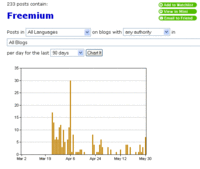What's in a word? Freemium
A couple of months ago, Fred Wilson blogged about his favorite business model, where web companies provide free use of their basic service, then offer premium versions and add-ons, available for a fee. As Fred pointed out, many successful companies have adopted this model (Skype, Flickr and Trillian, among others). Fred closed his post asking if there was a name for this model, and if not, what might be a good name.
Alacra's Jarid Lukin proposed the name "Freemium". And, from the looks of it, it seems to have stuck.
Tom Evslin used the term yesterday, in describing the Feedblitz business model. Feedblitz is familiar to those of you who read Content Matters via email. It takes my RSS feed and wraps it into an email and sends it to users who don't want to deal with RSS. It performs its job admirably, while costing me nothing. Under the Freemium model, Feedblitz charges for personalization of the emails and a frequency of more than once per day.
This week's issue of Wired Magazine also includes a reference to the Freemium model, in its article, Blogging for Dollars.
 This chart, from Technorati, shows how the term Freemium has expanded throughout the blogosphere. Its first appearance was in a March 23 follow-up post from Fred and was subject of a flurry of link love in the two weeks that followed. Since then, it's appeared on blogs 223 times, and that doesn't include the mainstream press like Wired or other websites.
This chart, from Technorati, shows how the term Freemium has expanded throughout the blogosphere. Its first appearance was in a March 23 follow-up post from Fred and was subject of a flurry of link love in the two weeks that followed. Since then, it's appeared on blogs 223 times, and that doesn't include the mainstream press like Wired or other websites.
The Freemium model has been around for a while, but seems to be flourishing in the Web 2.0 world. And, it's interesting to see the language spreading as virally as the applications themselves.















